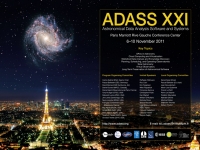Leonid Benkevitch (MIT Haystack Observatory),
Mark. D. Benjamin (REU student, Princeton
University), Divya. Oberoi (MIT Haystack Observatory, Igor. V. Sokolov
(AOSS, University of Michigan)
Abstract
We present a modeling framework HART (Haystack
and AOSS Ray Tracer) developed in
view of solar studies using the
latest generation of low-frequency (<300 MHz)
interferometer
arrays, such as Murchison Widefield Array (MWA) and Low
Frequency
Acquisition and Ranging array (LOFAR). Solar science
based on modern low
frequency radio telescopes requires reliable
numerical tools for image
interpretation. Low frequency radio
rays suffer significant refraction and
scattering in the corona,
hence the need for simulated images of the sun
exhibiting various
features (coronal streamers etc.) obtained through ray
tracing. A
correct analysis of low frequency images is impossible
without
quality ray tracing software.
HART is based
on a native high-efficiency ray tracing algorithm, allowing
fast
computation of multi-pixel solar brightness temperature (Tb)
images. The
algorithm uses no assumptions on symmetries of the
electron density distribution
and can be used for tracing the
rays in arbitrary geometries. It also implements
ray scattering
based on density fluctuation power spectra. Since any point
in
the solar system can be taken for the observer position, HART
can be used for
simulating images from heliospheric satellites.
The software implementation
works in parallel using modern
multi-core processors. We are planning to employ
it on GPUs in
the near future. The Tb computation method allows rendering
both
unpolarized and circularly polarized images, which is
instrumental in studying
solar magnetic fields and Alfven waves.
To prevent numerical instabilities, we
developed a method of
smooth polynomial ′stitching′ distributions of
different
dimensionalities (e.g., Saito's coronal model is 2D
while that of the
chromosphere is 1D). Electron density and
magnetic field in the numerical domain
can be provided both as
analytical models and in the form of ′data cubes′
with
results of an MHD simulation, e.g. from the SWMF framework.
The HART framework
includes mechanisms for modeling coronal
streamers in both density and magnetic
field. The resultant
images can be immediately plotted or the sequences of
images can
be saved in multi-dimensional FITS files.
To ensure both
high efficiency and user convenience, the HART framework
has a
three-layer structure. The fast algorithms at the lower level are
coded
in the C language. The middle layer is a Python module. It
allows convenient
access to all the simulation parameters and
arrays in the Python
environment at the command prompt. The upper
layer is the GUI, also written in
Python. It lets a user specify
important parameters and includes an interactive
interface for
specification of locations on the solar disk where to
place
streamer models or at which ray traces are to be plotted in
3D. Visualization
in HART is based on the Matplotlib package.
HART integrates many techniques into a simulation system
with a high-level
interface, while providing easy access to every
simulation parameter. HART's
design philosophy facilitates its
further development and extension.Poster in PDF format
Paper ID: P010
Poster Instructions
|

